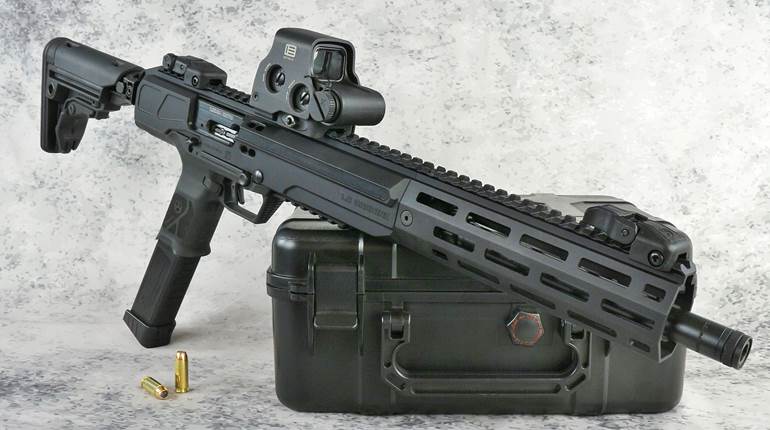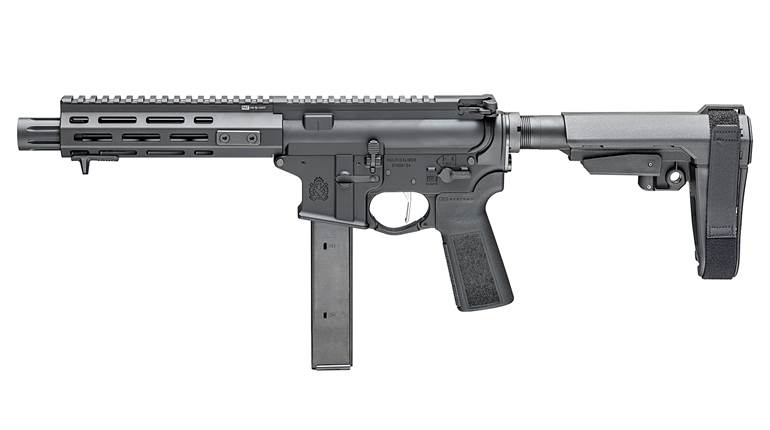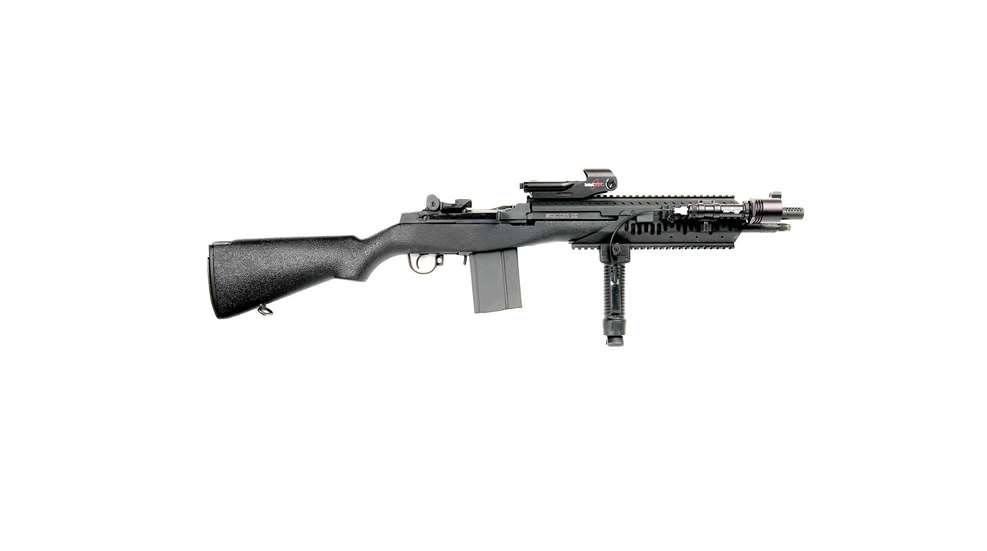
This feature article, “Springfield Armory’s SOCOM II: The Most Modern, Modular M1A,” appeared originally in the January 2006 issue of American Rifleman. To subscribe to the magazine, visit the NRA membership page and select American Rifleman as your member magazine.
Today, Springfield Armory maintains production of its M1A SOCOM line of gas-piston-operated, semi-automatic rifles. In fact, its SOCOM 16 CQB Rifle is a close replacement for its well-liked SOCOM II series that is no longer manufactured. The SOCOM 16 CQB, as tested by Field Editor B. Gil Horman where it was noted, “the SOCOM 16 CQB exhibited top-notch levels of fit and finish across the board. It passed its bench checks with flying colors and went on to perform admirably at the shooting range.” Horman also wrote, “The Springfield SOCOM 16 CQB M1A is an impressive piece of hardware. Its long and respected battlefield heritage has been preserved and enhanced for the needs of today's military and law enforcement personnel. It's certainly enough gun for those civilians who are looking for a defensive option that offers plenty of punch and a host of tactical features.” Check out this NRA Gun Of The Week video of the SOCOM II on the range at NRA HQ.
Visit Springfield-Armory.com to experience a striking array of modernized M1A rifles.
SOCOM II: The Most Modern, Modular M1A
“Once in a while a gun comes along that somehow seems to be far more than the sum of its parts.”
That opening statement, used by another author to describe Springfield Armory’s SOCOM 16 rifle in the pages of American Rifleman, aptly described the first “Good Scout.” That it remains an appropriate description of the new SOCOM II is further evidence that the original gun truly broke new ground.

This time around, the SOCOM II raises the bar yet again by blending the battle-tested M14-type design with the M1A Scout rifle’s practical engineering, and the SOCOM 16’s abbreviated package to place the new gun on par with other modern, modular close-quarters-combat long arms.
To understand the SOCOM II is to understand the parallel histories of the M14 and the scout rifle concept itself. We have become used to seeing long, forward-mounted Picatinny rails on .223-cal. M4 carbines in the hands of soldiers abroad or law enforcement personnel. But only a decade ago, forward-mounted optics were much more rare on tactical carbines. And while the SOCOM II is a “scout,” in terms of its ability to mount a forward optic, it is, first and foremost, an M1A—the semi-automatic-only version of America’s last .30-cal. infantry rifle, the M14.
A Dying Breed
A direct descendent of John Garand’s M1, the rotating-bolt, gas-operated, air-cooled M14 was adopted in 1956, but eight years later, in 1964, was superseded by Eugene Stoner’s M16. Still the M14 won the hearts and minds of nearly everyone who ever shouldered it. It remained a favorite in competitive circles, such as the NRA National Matches at Camp Perry, for decades after the close of the Vietnam War in which it saw combat.
In addition, the Navy and Marine Corps retained inventories of M14s as Designated Marksman Rifles, with a scoped, semi-automatic-dedicated action laid in a McMillan M2A stock. Meanwhile, the Army also retained some M14s, and the rifle has remained a staple of military culture, whether on the ceremonial drill fields of American posts, or as it has recently been called back to active duty in the modern day battlefields of Afghanistan and Iraq.
Cooper’s Influence
While the M14 eventually carved its niche into the modern fabric of specialized military and law enforcement marksmen, the scout rifle concept evolved a bit slower. The modern incarnation—the Germans had employed forward-mounted riflescopes as early as World War II—of the scout rifle belongs to none other than Col. Jeff Cooper. When in the early 1980s the former U.S. Marine led a series of Scout Rifle Conferences at the vaunted Gunsite Training Center in Arizona, which he founded, several firearm industry instructors, gunsmiths and journalists convened to examine the possibilities of creating the perfect general-purpose rifle. Borrowing from the Winchester Model 94 and the Mannlicher 6.5 mm carbine, Cooper and his panel attempted to design a rifle equally capable for use by the mobile, big-game hunter or by soldiers on long-distance missions.
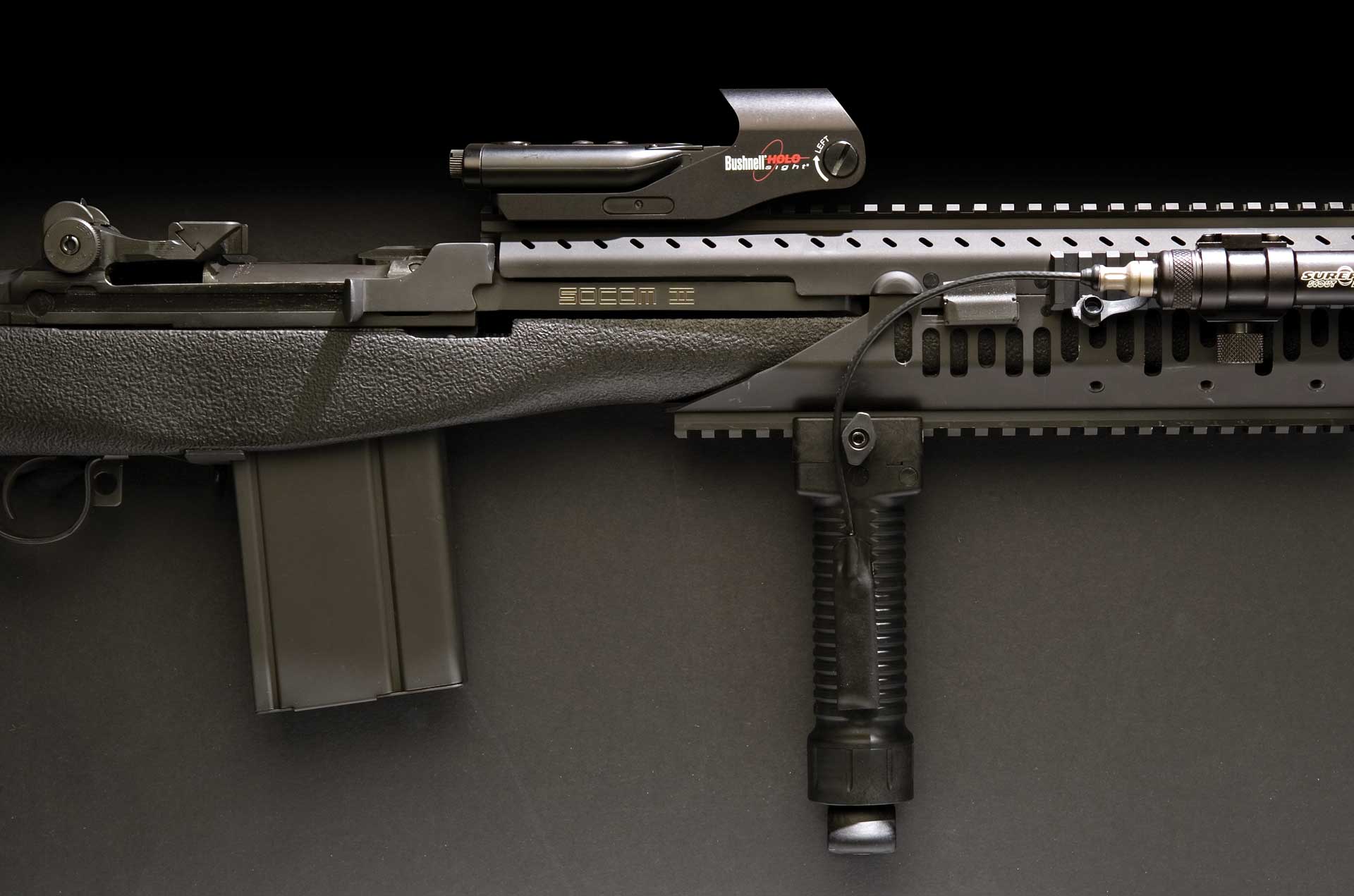
In the September 1985 American Rifleman, Cooper defined the attributes formulated by the Scout Conferences in an article entitled “The Scout Rifle.” It called for a short-action, short-barreled, lightweight rifle with compact sights and a synthetic stock. Cooper also demanded that the rifle be chambered in .30 caliber and that the action include a built-in aperture sight on the receiver bridge. Cooper’s scout concept was based on a bolt-action design, featuring a magazine cut-off, Mauser-style extractor and ejector and three-position safety. These features allowed the rifle to be carried one-handed at the balance point, loaded from the top via a stripper clip and topped off one round at a time via the magazine cut-off.
It was an ingenious collection of ergonomic, utilitarian functions. The major advantage of the scout concept, however, is that it allows the shooter to engage any target with both eyes open. While this isn’t always a necessity, it is certainly a welcome capability, especially for the tactical shooter. With both eyes open, he can take advantage of the full range of peripheral vision—a superior way to engage targets in a tactical situation. But, to Cooper, this was just the first advantage the scout concept had on the traditional rifle.
“There are many additional advantages to the forward telescope mount,” Cooper wrote. “It is out of the way when the rifle is carried at the balance. It may be mounted as low over the bore as the diameter of the bell permits. It avoids pinching between thumb and bolt handle when the bolt is operated. It permits stripper loading if desired. It greatly facilitates single-loading with eyes on target. It completely eliminates ‘telescope eye.’ Without exception, those who have tried the forward-mounted glass in a full course of rifle training are unanimous in their conviction that it is a superior system.”
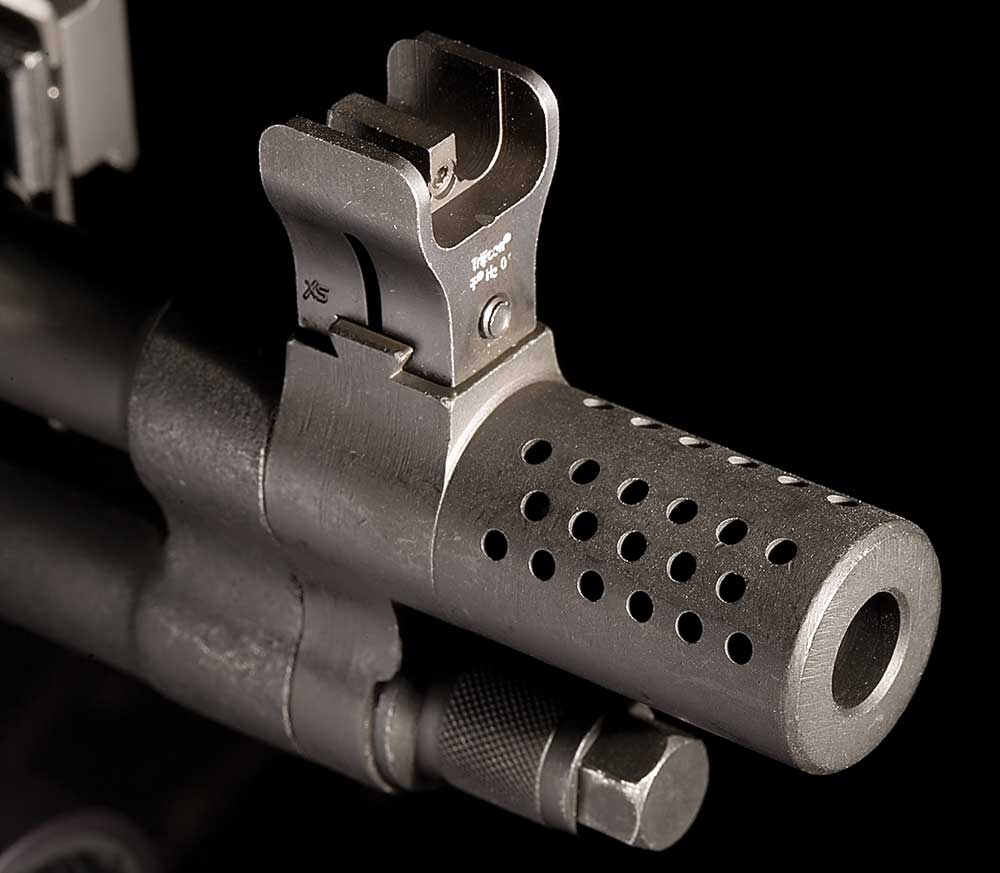
Through the conferences, several prototypes were built based on Remington, Ruger and Sako actions. Then in 1998, under Cooper’s guidance, Steyr introduced its SBS Scout, the closest match yet to the original design criteria. More recently, Ruger unveiled its own take on the scout rifle with the Ruger M77 Mark II Frontier. However, for the most part, the scout concept remained on the periphery of the gun industry.
Rebirth Of A Legend
By the time Cooper was refining his scout concept, the final ingredient to the SOCOM II mix was well underway in Geneseo, Ill. The current company had a decade earlier acquired a Texas firm that had adopted the name of the U.S. Armory at Springfield, Mass. With its proprietary receiver combined with mostly U.S. G.I. parts, the full-size 22"-barreled M1A had long since established itself as a quality military-style rifle suitable for competitive shooting. In a few short years, the company would turn out the first of its abbreviated M1As, the 18"-barreled Bush Rifle of 1989, and by 1996 would unveil the first M1A with a forward optic mount, the 18"-barreled Scout Squad. With the new, shorter, quicker-pointing guns, the M1A became even more versatile. The impact was immediate and the Scout versions of the M1A became a fixture in the Springfield line.
The 2004 introduction of the shortest scout of all, the SOCOM 16, brought the most radical M1A that had ever been seen outside specialty shops and military experimentation. First, the barrel was cut down even further, to a CQB-worthy 16¼". With such a short barrel, the .308 Win. can rock a shooter off target with recoil, which inspired Springfield to develop a more effective muzzle compensator. Utilizing a series of 34 ports—consisting of a 6-5-6 arrangement from the 11- to 9-o’clock positions—and a large interior chamber, the compensator vents gas away from the muzzle much more effectively than I could ever explain. Again, the coverage in these pages expressed it best: “Why this works as well as it does is a mystery to me, but more than a few shooters have watched the SOCOM 16 in action and made the observation that the muzzle seems to dip when it is fired.”
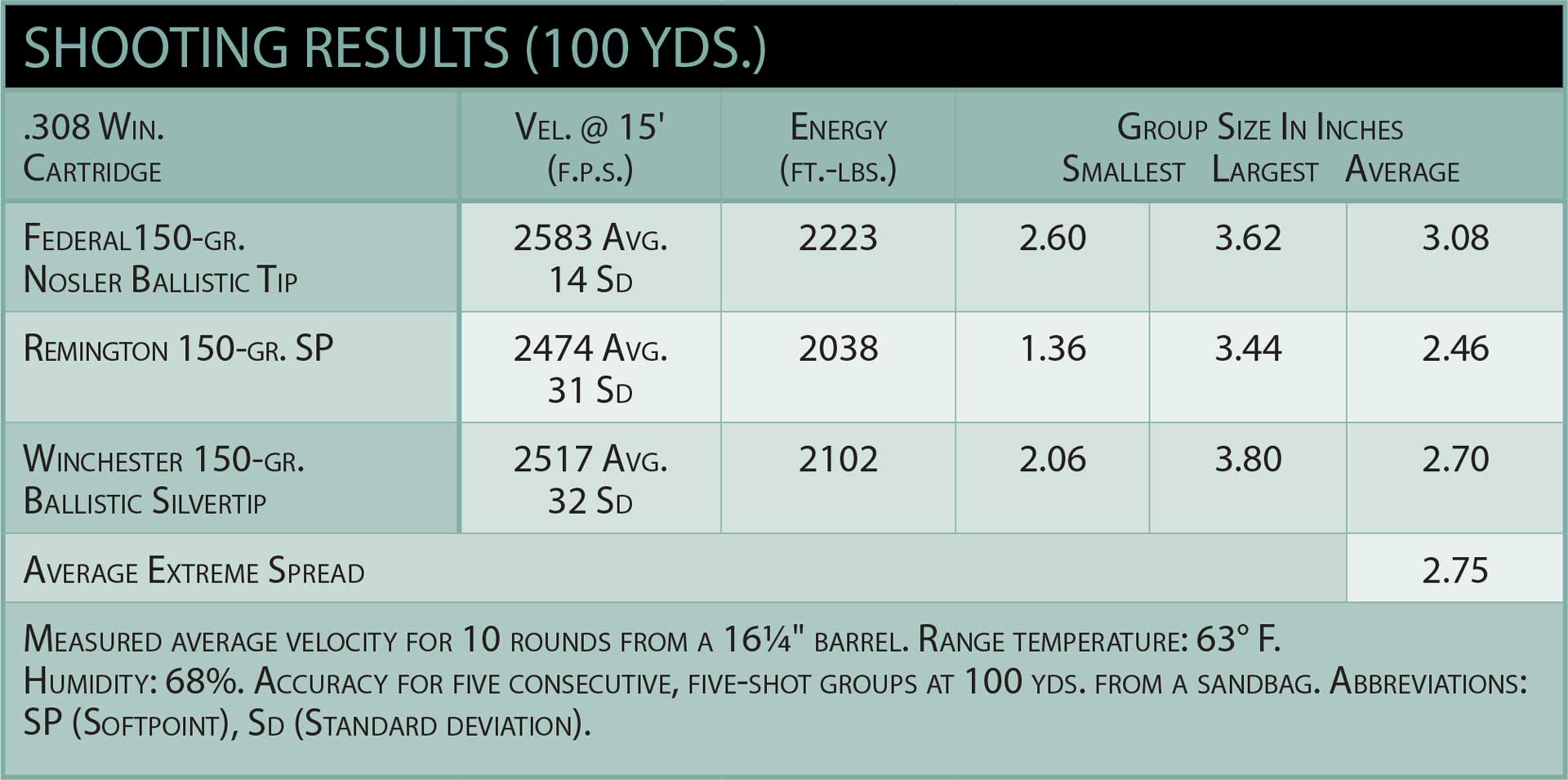
The SOCOM 16 was set in a late-production black fiberglass G.I. stock, which featured a very tactile, crinkle-finish paint that provided a sure grip for handling. An enlarged, ghost-ring aperture sight, fully adjustable for windage and elevation, was complemented with an XS Sight Systems 24/7 Tritium Stripe blade front sight. But for those with a more “tactical” bent, the SOCOM 16 still had a few shortcomings.
Today’s specialized paramilitary user or law enforcement professional often deploys much more than a scope or red-dot sight when going into harm’s way. The last decade has seen an explosion in the advancement of tactical lights and lasers, while the military has formally developed its own doctrine with the use of night-vision scopes. So as good as the SOCOM 16 was at turning the M14/M1A into a tactical carbine, there just weren’t enough forward attachment points on the SOCOM’s Picatinny rail.
Going All The Way
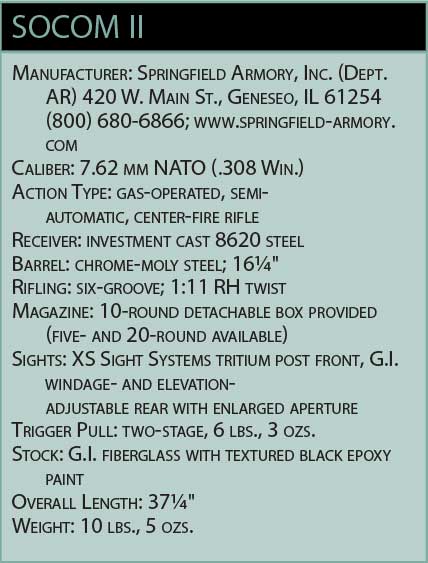
With Springfield’s new aluminum Cluster Rail System fore-end, the SOCOM II solves that problem emphatically. The top rail is now 12¾" long, and further utility is provided by a 5"-long rail on each side along with an additional 10" rail on the bottom. Also, the SOCOM II is effectively a modular rail system. The bottom rail of the Cluster Rail System is removable, without the need of tools, which gives users the option of customizing their rifle to meet certain mission-specific needs. For example, a shooter might decide to use a vertical fore-grip and weapon light on the underside Picatinny rail for a tactical situation. However, that same rifle could be used during a benchrest session more comfortably by removing the bottom rail. To remove it, simply depress the two spring-loaded takedown latches on opposing sides of the rail, then lift outward, rotating toward the muzzle. Reinstalling the rail is just as quick and easy by indexing on the appropriate pins and rotating the entire unit flush while holding back the takedown latches.
The SOCOM II also improves upon the original design in a few critical areas. The second variant returns to a traditional G.I.-spec gas plug, while the front sight is visibly more robust, which should give further protection to the Tritium front sight. The stock, still a G.I. fiberglass unit underneath, now features a durable epoxy paint finish that has what some consider a better feel.
Most of my colleagues here at NRA have come to think of the original SOCOM 16 as the ultimate ranch gun. It’s a handy, portable rifle that can engage targets at extended ranges. On the other hand, the SOCOM II is to the M1A what the M4 Carbine is to the M16. It starts with the parent and allows the attachment of a nearly unlimited array of lights, lasers and sights.
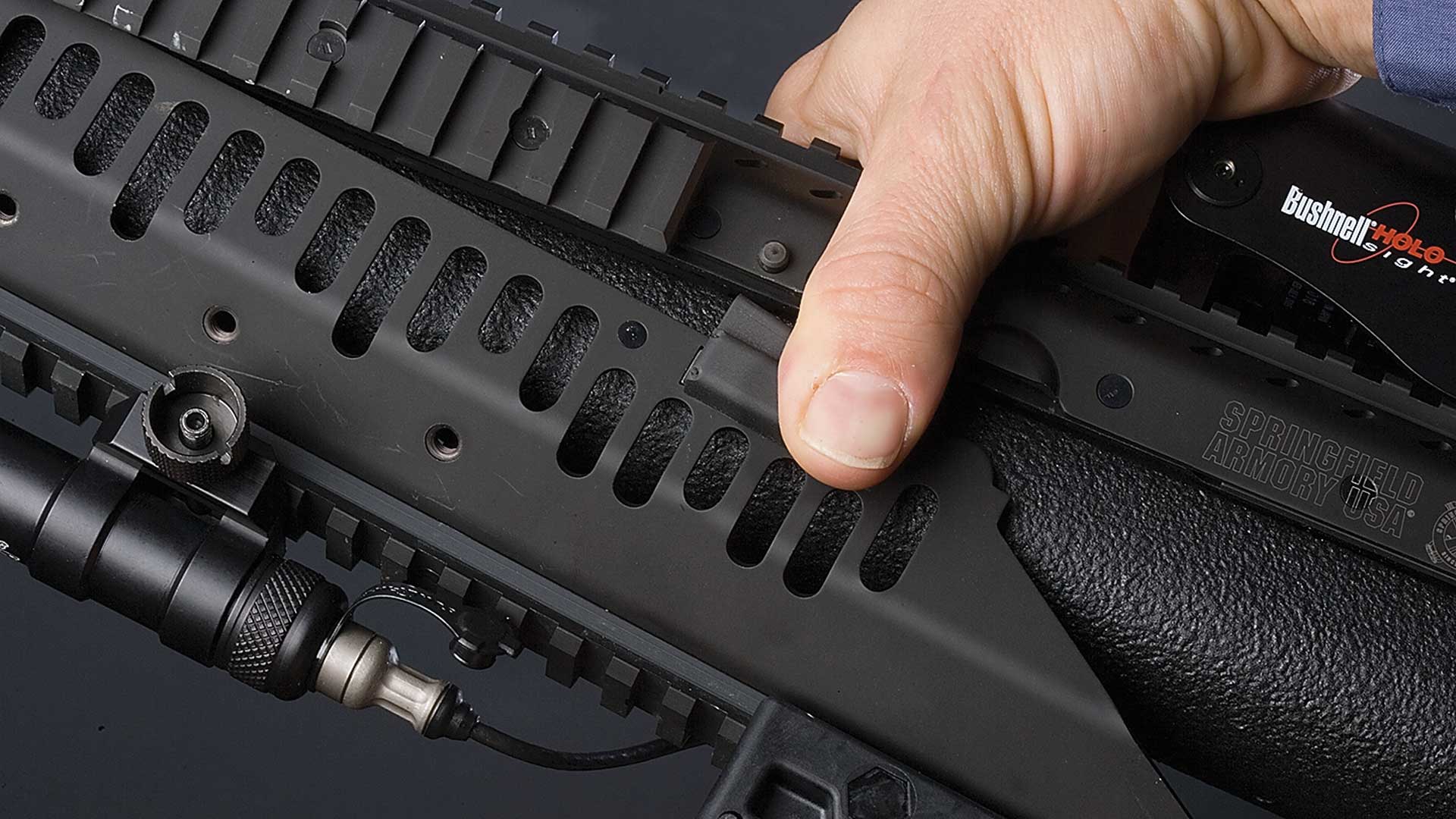
The only downside of the SOCOM II is its weight. At 10 lbs., 5 ozs., the SOCOM II is as heavy out of the box as many M4 systems are with all their gear attached. However, that said, there are still some worthy functions of the SOCOM II in the hands of civilians. With a bipod and a good long-range optic, the rifle can turn in a very capable day as a ranch gun or plinker. And if you can shoulder the weight, it’s hard to argue against the tactical capabilities of this rifle to defend a home, utilizing the contemporary complement of lights, lasers and training.
For the specialized security provider or law enforcement personnel, the SOCOM II becomes a highly specialized arm. Most units or agencies won’t abandon the M16/AR-15 platform anytime soon. But for those who need a more effective cartridge chambering on a dependable platform, without sacrificing modular system capability and the specialized accessories needed on the modern battlefield, the SOCOM II becomes a very enviable choice.












